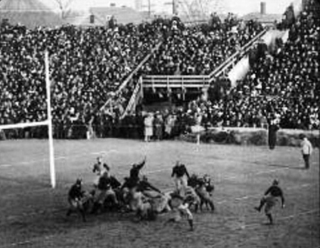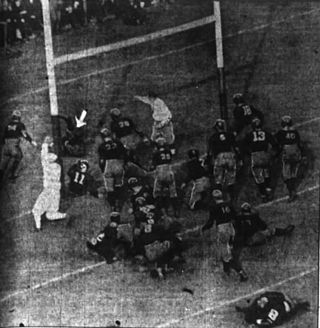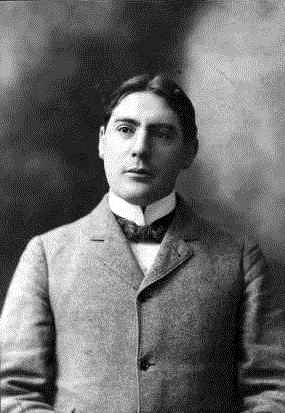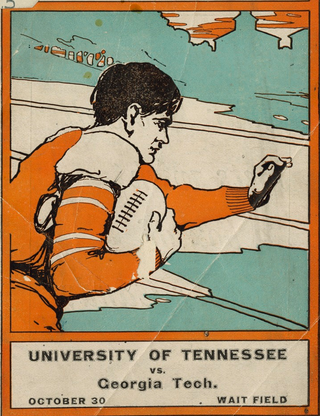
Fielding Harris Yost was an American college football player, coach and athletics administrator. He served as the head football coach at: Ohio Wesleyan University, the University of Nebraska, the University of Kansas, Stanford University, San Jose State University, and the University of Michigan, compiling a coaching career record of 198–35–12. During his 25 seasons as the head football coach at Ann Arbor, Yost's Michigan Wolverines won six national championships, captured ten Big Ten Conference titles, and amassed a record of 165–29–10.

The 1907 college football season saw the increased use of the forward pass, which had been legalized the year before. Football remained a dangerous game, despite the "debrutalization" reforms, and an unprecedented eleven players were killed, while 98 others were seriously injured. However, there were no serious injuries reported among the major colleges. The Yale Bulldogs, unbeaten with a record of 9–0–1, had the best record. The Helms Athletic Foundation, founded in 1936, declared retroactively that Yale had been the best college football team of 1907. Yale and Penn both claim 1907 as a national championship season. Although Yale was named as champion by 6 different entities, Penn was not named champion by any. Penn's claim to the championship is only by the university itself.

The 1906 college football season was the first in which the forward pass was permitted. Although there was no clear cut national championship, there were two teams that had won all nine of their games as the 1906 season drew to a close, the Princeton Tigers and the Yale Bulldogs, and on November 17, 1906, they played to a 0–0 tie. St. Louis University finished at 11–0–0. The Helms Athletic Foundation, founded in 1936, declared retroactively that Princeton had been the best college football team of 1906. Other selectors recognized Yale as the national champions for 1906.

The 1912 college football season was the first season of the modern era of college football, as the NCAA implemented changes to increase scoring:

The 1922 college football season had a number of unbeaten and untied teams, and no clear-cut champion, with the Official NCAA Division I Football Records Book listing California, Cornell, Iowa, Princeton, and Vanderbilt as national champions. California, Cornell, and Princeton were all picked by multiple selectors.

The 1908 college football season ran from Saturday, September 19, to November 28. The Penn Quakers and the Harvard Crimson each finished the season unbeaten but with one tied. The LSU Tigers went unbeaten and untied against a weaker opposition. All three teams were named national champions retroactively by various organizations. Only Pennsylvania officially claims a national championship for the 1908 season. Kansas also went undefeated, but did not make a claim for the national championship.

The Lafayette Leopards football program represents Lafayette College in Easton, Pennsylvania in college football. One of the oldest college football programs in the United States, Lafayette currently plays in the Patriot League at the NCAA Division I Football Championship Subdivision level.

The Penn Quakers football program is the college football team at the University of Pennsylvania in Philadelphia. The Penn Quakers have competed in the Ivy League since its inaugural season of 1956, and are a Division I Football Championship Subdivision (FCS) member of the National Collegiate Athletic Association (NCAA). Penn's first game was in 1876, and the team has played in 1,413 football games, the most of any school in any division. Penn plays its home games at historic Franklin Field, the oldest football stadium in the nation. All Penn games are broadcast on WNTP or WFIL radio.

Parke Hill Davis was an American football player, coach, and historian.

The 1909 college football season was the first for the 3-point field goal, which had previously been worth 4 points. The season ran from Saturday, September 25, until Thanksgiving Day, November 25, although a few games were played on the week before.

The 1896 college football season had no clear-cut champion, with the Official NCAA Division I Football Records Book listing Lafayette and Princeton as having been selected national champions. Lafayette finished with an 11–0–1 record while Princeton had a 10–0–1 record. In the second game of the season for both teams, Lafayette and Princeton played to a scoreless tie. Both teams had signature wins: Lafayette defeated Penn 6–4, giving the Quakers their only loss of the season, while Princeton defeated previously unbeaten Yale, 24–6, on Thanksgiving Day in the last game of the season. Princeton was retroactively named the 1896 national champions by the Billingsley Report, the Helms Athletic Foundation, the Houlgate System, and Lafayette and Princeton were named national co-champions by the National Championship Foundation and Parke Davis.
The 1908 Penn Quakers football team was an American football team that represented the University of Pennsylvania as an independent during the 1908 college football season. In their first season under head coach Sol Metzger, the Quakers compiled an 11–0–1 record, shut out seven of twelve opponents, and outscored all opponents by a total of 215 to 28.

The 1896 Princeton Tigers football team was an American football team that represented Princeton University as an independent during the 1896 college football season. The team finished with a 10–0–1 record, shut out 10 of 12 opponents, and outscored all opponents by a total of 266 to 5. Franklin Morse was the head coach, and Garrett Cochran was the team captain.
The 1897 Yale Bulldogs football team was an American football team that represented Yale University as an independent during the 1897 college football season. The team finished with a 9–0–2 record, shut out seven of eleven opponents, and outscored all opponents by a total of 170 to 35. Frank Butterworth was the head coach.
The 1899 Yale Bulldogs football team represented Yale University in the 1899 college football season. The team compiled a 7–2–1 record, recorded eight shutouts, and outscored all opponents by a total of 191 to 16. The team defeated Wisconsin (6–0), Army (24–0), and Penn State (42–0), played a scoreless tie against Harvard, and lost to Columbia (0–5) and Princeton (10–11).
The 1901 Army Cadets football team represented the United States Military Academy in the 1901 college football season. In their first and only season under head coach Leon Kromer, the Cadets compiled a 5–1–2 record, shut out four opponents, and outscored all opponents by a combined total of 98 to 22. The team's only loss was by a 6 to 0 score against an undefeated Harvard team that has been recognized as a co-national champion for the 1901 season. The Cadets also tied with Yale (5–5) and Princeton (6–6). In the annual Army–Navy Game, the Cadets defeated the Midshipmen by an 11 to 5 score.
The 1909 Penn Quakers football team represented the University of Pennsylvania in the 1909 college football season. The Quakers finished with a 7–1–2 record in their first year under head coach and College Football Hall of Fame inductee, Andy Smith. Their only loss was to Michigan by a 12 to 6 score, a game that snapped Penn's 23-game winning streak and marked the first time a Western team had defeated one of the "Big Four". Other significant games included a 12 to 0 victory over West Virginia, a 3-3 tie with Penn State, a 29 to 6 victory over Carlisle, and a 17 to 6 victory over Cornell. They outscored their opponents by a combined total of 146 to 38. End Harry Braddock was the only Penn player to receive All-America honors in 1909, receiving second-team honors from Walter Camp.
The 1893 Penn Quakers football team represented the University of Pennsylvania in the 1893 college football season. The Quakers finished with a 12–3 record in their second year under head coach and College Football Hall of Fame inductee, George Washington Woodruff. Significant games included victories over Navy (34–0), Penn State (18–6), Lafayette (82–0), and Cornell (50–0), and losses to national champion Princeton (4–0), Yale (14–6), and Harvard (26–4). The 1893 Penn team outscored its opponents by a combined total of 484 to 62. No Penn players were honored on the 1893 College Football All-America Team, as all such honors went to players on the Princeton, Harvard and Yale teams.
The 1892 Penn Quakers football team represented the University of Pennsylvania in the 1892 college football season. The Quakers finished with a 15–1 record in their first year under head coach and College Football Hall of Fame inductee, George Washington Woodruff. Significant games included victories over Penn State (20–0), Navy (16–0), Lafayette, and Princeton (6–4), and its sole loss to undefeated national champion Yale (28–0). The 1892 Penn team outscored its opponents by a combined total of 405 to 52. Penn halfback Harry Thayer was selected by both Walter Camp and Caspar Whitney as a first-team player on the 1892 College Football All-America Team.
The 1891 Penn Quakers football team represented the University of Pennsylvania in the 1891 college football season. The Quakers finished with an 11–2 record in their fourth year under head coach E. O. Wagenhorst. Significant games included victories over Rutgers (32–6), Lafayette, and Lehigh, and losses to Princeton (24–0) and undefeated national champion Yale (48–0). The 1891 Penn team outscored its opponents by a combined total of 267 to 109. Penn center John Adams was selected by Caspar Whitney as a first-team player on the 1891 College Football All-America Team. 1891 was last year John Heisman played for Penn.












